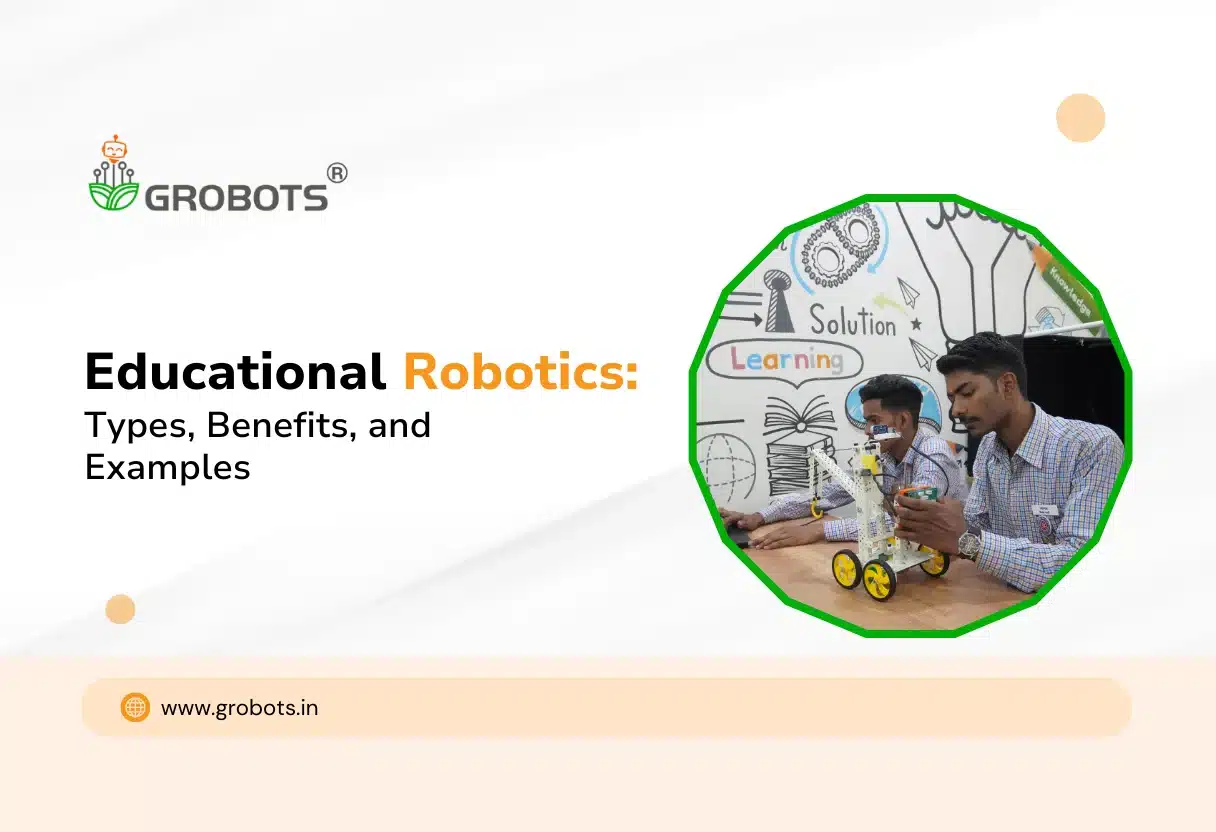Educational robotics is the use of robotic systems and platforms as an interactive learning tool to facilitate education. It provides students with hands-on experiences, combining knowledge from STEM subjects to build and program robots.
The main objective is to develop:
- Critical thinking,
- Creativity, and
- Problem-solving skills among learners.
Additionally, educational robotics not only enhances understanding of complex concepts but also fosters a sense of curiosity and exploration. Thus, making learning both fun and impactful.
As educational institutions continue to embrace these technologies, the potential for transforming traditional teaching methods and inspiring future innovators becomes limitless. Therefore, in this guide, we will understand everything about educational robotics.
Importance in Modern Education
In an era defined by rapid technological advancements, educational robotics has become essential. By integrating robotics into the curriculum, educators can prepare students for a tech-driven future.
It fosters a deep understanding of how technology works and instills an early appreciation for engineering and computer science concepts.
Additionally, educational robotics encourages students to apply theoretical knowledge in practical contexts, bridging the gap between learning and real-world applications. This interactive learning approach nurtures curiosity and engagement. Thus, making complex concepts more accessible.
Furthermore, by participating in robotics activities, students learn to navigate challenges, equipping them with resilience and adaptability that are crucial in today’s fast-paced world.
Types of Educational Robotics
As we now know the importance of education robotics, it’s time to learn about its types:
Humanoid Robots
Humanoid robots resemble human forms and mimic human-like actions, making them a valuable teaching aid. These robots often have articulated arms, facial expressions, and speech capabilities. As a result, this allows students to engage in interactive learning.
Features and Applications: Humanoid robots can simulate real-life scenarios, teach languages, and assist in developing social skills. Examples include NAO and Pepper robots, which are used in classrooms to enhance student engagement.
Benefits: They help students understand complex concepts in a relatable manner and can cater to different learning paces.
Benefits of Educational Robotics in Learning
Robotics education provides numerous advantages that extend beyond the classroom, preparing students for real-world challenges. JHere are some of them:
Enhancing Problem-Solving Skills
Robotics challenges students to think critically as they troubleshoot and refine their projects. Solving robotic issues requires logic, trial and error, and resilience, skills that are transferable to any academic or life situation.
Fostering Creativity and Innovation
Building robots from scratch or modifying existing designs encourages creative thinking. Students are empowered to experiment and explore multiple solutions, helping them develop innovative approaches to problem-solving.
Developing Teamwork and Collaboration
Robotics projects often require students to work in teams, promoting collaboration and the sharing of ideas. As a result, this interaction enhances communication skills and teaches students to work effectively in group settings.
Real-World Application
Educational robotics also provides students with opportunities to see the practical applications of their learning. They can design projects that address real-world problems. Thus, further enhancing their understanding and engagement.
Key Components of Educational Robotics Kits
Understanding the fundamental components of robotics kits is crucial for educators and students alike. Let’s understand the key components:
Microcontrollers and Sensors
Microcontrollers act as the brain of a robot, processing inputs from various sensors and executing commands. These sensors include light, touch, and infrared, which help the robot interact with its environment.
Motors and Actuators
Motors and actuators provide movement to the robot, enabling it to perform tasks such as rolling, walking, or gripping objects. Understanding how these components function helps students grasp the basic principles of mechanics and electronics.
Programming Interfaces
Robotics kits often come with programming interfaces that make coding accessible to beginners. Platforms like Scratch, Blockly, and Python allow students to create codes for controlling the robot’s behavior.
Connectivity Options
Many robotics kits offer connectivity features, such as Bluetooth or Wi-Fi. Thus, enabling students to control robots remotely or integrate them with other technologies, enriching the learning experience.
Examples of Educational Robotics in Schools
Through various classroom projects and competitions, students experience firsthand the excitement of bringing their ideas to life.
Classroom Projects and Activities
Robots are used in schools to teach basic programming and engineering. For instance, students can build robots that follow a path or respond to light using simple sensors.
- Real-Life Applications: Robotics can help illustrate principles of physics, such as motion and force, by applying theoretical knowledge to practical tasks.
Robotics Competitions
Competitions like FIRST Robotics and the World Robot Olympiad encourage students to put their robotics knowledge to the test.
- Building Practical Skills: These events push students to think outside the box, apply problem-solving skills, and learn to work under pressure.
How to Integrate Educational Robotics in the Curriculum
Implementing educational robotics into the curriculum requires thoughtful planning and execution. So, here are step-by-step process:
Step-by-Step Guide for Teachers:
Building a maze-solving robot as a group project fosters teamwork and enhances problem-solving skills. The collaborative approach allows students to share ideas and tackle challenges together.
By utilizing a grobots robotics kit that includes all necessary sensors, teams can efficiently work toward a common goal.
- Assess Learning Objectives: Identify the skills you aim to develop, such as programming, mechanics, or teamwork.
- Choose Appropriate Robotics Kits: Select kits suitable for the age and skill level of your students.
- Plan Hands-On Activities: Develop lesson plans that allow students to build, program, and test their robots.
- Incorporate Interdisciplinary Learning: Connect robotics projects with other subjects to enhance overall learning.
- Evaluate and Reflect: After each project, discuss what worked well and what could be improved, fostering a growth mindset.
Common Challenges in Implementing Educational Robotics
While educational robotics presents exciting opportunities for enhancing learning, it also comes with its set of challenges.
- Cost and Accessibility: Robotics kits and tools can be costly, limiting access for some schools. Solutions include applying for educational grants and using more budget-friendly kits.
- Training Teachers: Teachers need adequate training to integrate robotics effectively. Professional development programs and workshops can be a solution.
- Technical Limitations: Issues such as outdated software or hardware malfunctions can disrupt lessons. Regular updates and proper maintenance can mitigate these challenges.
The Future of Educational Robotics
The landscape of educational robotics is continually evolving, influenced by advancements in technology and pedagogy. These developments not only excite educators and students but also hold the potential to transform how we approach learning in the digital age.
Trends in Robotics Education
One of the most prominent trends is the integration of advanced robotics technologies, including AI-powered bots that can adapt to individual learning styles and needs.
These intelligent systems will not only respond to student interactions but also analyze their learning progress. Thus, enabling personalized education pathways. This adaptability can help educators tailor lessons to fit diverse learning preferences.
Moreover, as more schools recognize the importance of STEM education, we can expect a broader adoption of robotics programs that encourage critical thinking and problem-solving skills from an early age.
Emerging Technologies
Additionally, the rise of robots equipped with machine learning capabilities and enhanced sensor technologies will revolutionize the way students interact with educational content.
These advanced robots will facilitate more interactive and personalized learning experiences. Hence, allowing students to explore complex concepts in a hands-on manner.
For instance, robots that utilize sophisticated sensors will be able to assess their surroundings and make decisions based on real-time data.
Furthermore, as connectivity improves with the Internet of Things (IoT), classrooms will likely see a greater integration of robotics with other digital tools and resources.
Conclusion
Educational robotics is transforming how students learn and interact with technology.
By incorporating robotics into the curriculum, schools can provide an engaging, practical learning experience that equips students with skills for future careers in technology and engineering.
The benefits of integrating these tools far outweigh the challenges, making educational robotics a valuable addition to modern education.
Frequently Asked Questions (FAQs)
What is educational robotics?
Educational robotics involves using robots as learning tools in schools to teach STEM concepts, problem-solving, and critical thinking.
How does educational robotics benefit students?
It enhances learning by providing hands-on experience, developing problem-solving skills, and fostering creativity and collaboration.
What are the different types of educational robots?
Types include humanoid robots and pre-programmed robots, each serving different educational purposes.
How do I start using educational robotics in my school?
Start by assessing learning objectives, choosing the right robotics kits, and planning interactive lessons.
What are some examples of popular educational robotics platforms?
Popular platforms include LEGO Mindstorms and VEX Robotics, both known for their comprehensive educational resources.




